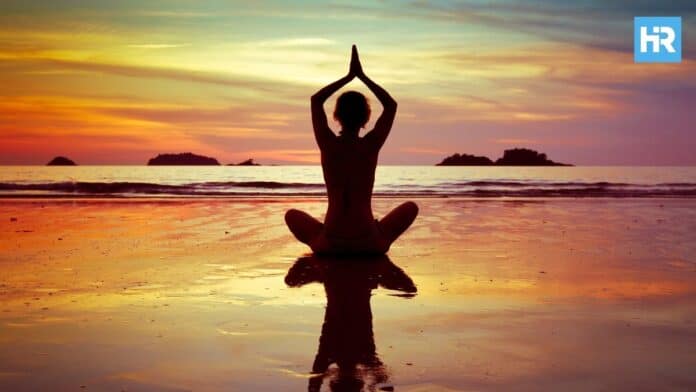Let’s get one thing straight: yoga is much more than mastering the impressive poses you see on Instagram.
The word “yoga” comes from the Sanskrit word “yuj,” which means “to join” or “to unite”. In fact, yoga symbolizes the connection of body, mind, and soul.
Yoga brings you back to that perfect balance, a state of self-discovery where you feel one with the world.
From the ancient mystics of India to the global wellness studios of today, the main goals of Yoga are to find inner peace, gain strength, and bring clarity to our often chaotic lives.
So, why did ancient mystics choose yoga, and how did it become popular across continents?
Well, grab a comfy seat, maybe even do a little stretching, and let’s explore yoga’s journey from sacred roots to modern phenomenon.
- Yoga started over 5,000 years ago as a way to connect body, mind, and spirit in India and has since spread worldwide.
- Over centuries, yoga has evolved into different styles, such as Hatha, Raja, and Ashtanga, each offering unique ways to grow and find peace.
- Today, yoga is a popular way for people of all ages and backgrounds to stay healthy, calm, and strong.
The Origins of Yoga: Ancient Mystics and the Birth of an Art
Interestingly, yoga has roots that go way back; we talked about it thousands of years ago.
It all began in Ancient India.
In the misty, early days of civilization, before religions even existed, yogis in the Indus-Saraswati River Valley (around modern-day India and Pakistan) meditated, moved, and breathed in ways that helped them feel closer to the universe.
Shiva and the Saptarishis: The First Yogi and His Disciples
In yogic lore, the tale starts with Shiva, considered the first-ever yogi, or Adiyogi.
According to legend, Shiva sat in meditation by a Himalayan lake, emanating a peaceful yet intense energy that the seven sages, or Saptarishis, couldn’t ignore.
Eventually, these sages begged Shiva to teach them his secrets.
He finally agreed, and they became the first students of this ancient art.
They traveled across Asia, the Middle East, and beyond, carrying Shiva’s teachings.
India, however, became the heart of yoga, where it would grow, change, and eventually thrive.
The Vedas and Upanishads: Early Scriptures
Some of the earliest mentions of yoga come from the Rig Veda, the oldest Vedas (ancient Indian texts), dating back over 5,000 years.
The Vedas are a collection of hymns and mantras used by Vedic priests, and they touch on early yoga concepts.
Later, the Upanishads (about 200 sacred scriptures) expanded on these ideas, describing more inward journeys of self-realization and meditation.
Yoga began shifting from rituals and mantras to a more internal, reflective practice to connect the individual spirit with the universal spirit.
Development Through the Ages: From Philosophies to Physical Practices
From 500 BCE to 800 CE, yoga began to take on recognizable forms and practices.
Two key figures of this era, Buddha and Mahavira, introduced new philosophical layers to yoga, focusing on peace and self-control.
Around this time, yogis started identifying three main paths to inner growth:
- Jnana Yoga (the path of knowledge)
- Bhakti Yoga (the path of devotion)
- Karma Yoga (the path of action)
The famous Bhagavad Gita, one of India’s treasured epics, was written around 500 BCE and further developed these paths.
In it, Krishna shares yoga wisdom with Arjuna, a warrior facing an internal struggle, explaining how these three paths can lead to inner peace.
Patanjali and the Eightfold Path
Fast forward to the 2nd century BCE, and we meet Patanjali, a revered sage often called the “father of yoga.”
Patanjali didn’t invent yoga, but he did organize and document it.
In his Yoga Sutras, Patanjali outlined an eightfold path called “Ashtanga” that guides one toward enlightenment:
- Yama – Moral discipline
- Niyama – Positive observances
- Asana – Physical postures
- Pranayama – Breath control
- Pratyahara – Withdrawal of senses
- Dharana – Focused concentration
- Dhyana – Meditation
- Samadhi – Enlightenment
While physical postures (asanas) are a big part of yoga today, Patanjali only mentioned them briefly.
Instead, his main focus was self-discipline and controlling the mind, with physical poses acting as a small part of the bigger picture.
Yoga’s Evolution: The Hatha Era and the Spread to the West
Between 800 CE and 1700 CE, yoga saw massive transformations.
This period often called the post-classical era, brought Hatha yoga, which emphasizes physical practices and breathwork to prepare the body for deeper states of meditation.
This was a turning point because people began focusing on the physical side of yoga, developing postures and breathing techniques that we recognize today.
Hatha Yoga: Embracing the Body’s Potential
Hatha yoga became popular among yogis who saw the body as a temple and a tool for achieving inner peace.
Teachers like Gorakshanath and Swatmaram Suri from the Nath tradition helped shape these practices, stressing the importance of physical health in accessing spiritual states.
It was also during this time that more practical yoga techniques emerged aimed at purifying the body and mind.
With these methods, yoga became more accessible and appealing, and soon, India was teeming with different yoga schools.
However, it wasn’t until the late 1800s that yoga spread beyond India’s borders and caught the attention of the Western world.
Swami Vivekananda: The First Yoga Ambassador to the West
In 1893, Swami Vivekananda, an Indian monk with a fierce intellect and peaceful presence, attended the World’s Parliament of Religions in Chicago.
There, he introduced Western audiences to yoga and Hindu philosophy, which ignited curiosity and admiration.
Vivekananda’s message of yoga as a “science of the mind” introduced a new perspective and resonated with intellectuals and spiritual seekers alike.
So, as you can imagine, his lectures and teachings were the first big steps in bringing yoga to the West.
The Modern Yoga Boom: From Ashrams to Mainstream Wellness
The early 20th century saw more yoga masters traveling to the West, teaching yoga’s mental and spiritual benefits.
Key figures included Paramahansa Yogananda, who wrote the popular Autobiography of a Yogi, and B.K.S. Iyengar, who developed Iyengar Yoga, a style that focuses on precise alignment and uses props to make yoga accessible for everyone.
Yoga Hits Hollywood and Beyond
In 1947, Indra Devi, one of the first Western women to train in India, opened a yoga studio in Hollywood.
Devi’s studio, with clients like Greta Garbo and Gloria Swanson, helped spark interest in yoga as a spiritual and physical discipline.
As Hollywood embraced yoga, it began to spread nationwide, moving from niche to mainstream.
During the 1960s and ‘70s, yoga gained even more momentum in the West.
Spiritual seekers, counterculture icons, and wellness enthusiasts began adopting yoga as part of a healthy lifestyle.
Today, yoga has grown into a global phenomenon practiced in countless forms, from the traditional to the modern, adapting ancient philosophies with today’s fast-paced lifestyles.
Yoga’s Core Practices: Not Just Physical, but Mental and Spiritual
At its core, yoga is about much more than postures.
Here’s a breakdown of some essential practices that create a holistic experience:
1. Asanas: Physical Poses that Ground You
Yes, the poses are a big part of yoga, but not for the reasons we might think. In ancient yoga, asanas were meant to prepare the body for meditation.
When you hold a pose, you focus not only on your physical body but also on your breath and mind, which, in turn, fosters awareness and stability.
2. Pranayama: The Power of Breath
Pranayama, or breath control, helps clear the mind and energize the body.
One of the most common forms is ujjayi breathing, which involves a steady inhalation and exhalation through the nose while slightly constricting the throat.
This creates a sound similar to ocean waves and helps calm the mind.
Pranayama teaches you to control your breath, which helps you manage stress and anxiety.
3. Meditation: The Heart of the Practice
Meditation, or dhyana, is where yoga truly shines.
It’s about focusing inward, silencing the mind, and finding that calm center within.
Whether you’re practicing mindfulness for a few minutes or aiming for deeper meditation, this practice cultivates a mental state of peace, clarity, and connection to yourself.
4. Mantras: The Sounds That Ground Us
Have you ever heard “Om” chanted in a yoga class?
Well, that’s a mantra, and it’s a repetitive sound used to help focus the mind.
It’s incredible how chanting can help clear mental clutter and bring a feeling of peace.
Other mantras include sounds and phrases like “So Hum” or “Om Shanti,” which yogis believe connect them with universal energies.
Yoga in Today’s World: Diverse Practices and Global Influence
Yoga has come a long way from its mystical roots in ancient India.
Today, there are over a dozen popular styles, each catering to different needs and preferences.
Here’s a glimpse into some popular forms of yoga you might encounter:
- Hatha Yoga: The classic, gentle style focusing on basic poses and slow movements. And it’s perfect for beginners.
- Vinyasa Yoga: A flowing style that connects breath with movement, often more fast-paced.
- Iyengar Yoga: Known for precision and alignment, it uses props like blocks and straps.
- Ashtanga Yoga: A rigorous practice involving a set sequence of poses; it’s challenging but great for building strength and endurance.
- Bikram/Hot Yoga: This style combines sweat, strength, and flexibility and is practiced in a heated room.
These styles show just how flexible yoga has become.
Whether you’re after a workout, mental clarity, or a way to unwind, there’s a form of yoga for everyone.
How Social Media Has Changed Yoga
In recent years, yoga has exploded on social media, where yogis post their journey, tips, and practices.
As you can expect, this exposure has made yoga more accessible than ever, but it’s also brought some unique challenges.
The focus on picture-perfect poses sometimes creates pressure to achieve advanced postures rather than embracing yoga’s true goal of inner peace.
But at its best, social media has created a supportive, global yoga community that inspires millions to try yoga.
Women and Yoga: Reclaiming the Practice
While the ancient roots of yoga saw men and women practicing, history largely documented the journey of male yogis.
In recent decades, however, women have become the majority in yoga communities worldwide, adapting and transforming yoga to fit different lifestyles, bodies, and needs.
Teachers like Indra Devi and, later, modern influencers have helped create an inclusive space for all.
Plus, women’s voices have helped yoga shift from rigid, prescriptive practices to more intuitive, personalized approaches.
This evolution reflects a balance between the masculine and feminine energies that yoga has always honored.
Now, yoga welcomes everyone, regardless of gender, background, or ability.
Why Yoga is Here to Stay
Yoga’s journey from ancient India to a worldwide wellness phenomenon is a story of resilience, adaptability, and timeless wisdom.
While yoga offers incredible physical benefits, its true value lies in its ability to bring peace, clarity, and connection to our lives.
Whether you’re a seasoned yogi or a curious beginner, yoga provides a sanctuary in today’s fast-paced world—a moment to breathe, reflect, and remember who you truly are.
And the best part is that yoga meets you where you are.
So whether you’re looking to stretch, meditate, or just find a bit more calm in your day, yoga’s always there.
It’s more than a workout—it’s a path to wellness, unity, and self-discovery.
Yoga, after all, is a way of being.






